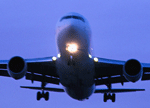Over the weekend, the AP reported that faulty airspeed indicators (pitot tubes) had been found on Northwest Airlines Airbus 330s that caused pilots not to know their airspeed on at least a dozen flights. Airspeed indicators are thought to be a contributing factor to the loss of Air France 447, although French accident investigators continue to insist they have no evidence that says the crash was caused by or related to problems with the pitot tubes.
The AP story says that the incidents were brief and all occurred when in the Intertropical Convergence Zone, which extends from 5 degrees north to 5 degrees south of the equator. The problems were found because of a detailed review undertaken by the airline after the Air France crash and the resulting publicity surrounding it.
These reported air speed indicator incidents were separate from a more widely reported Airbus incident involving a Northwest flight outside of Kagoshima, Japan on 23 June. Quoting from the National Transportation Safety Board (NTSB):
"The crew reported that they were in normal cruise at FL390 and in visual conditions with some convective weather displayed on radar about 25 miles north of track, with thin cirrus clouds ahead. After entering the cirrus and moderate precipitation and turbulence, the crew observed, and FDR confirms, the autopilot and autothrust switch off, and the aircraft switched to Alternate Law. The master caution and warning messages were activated. The crew followed flight manual procedures and the autopilot and normal law returned in about one minute, however the event quickly repeated itself, lasting for about 2 minutes. The crew turned the airplane 60 degrees off course to exit the weather as soon as the anomalous indications were observed. The autopilot, autothrust and other controls returned to functioning, but the airplane remained in alternate law for the rest of the flight. The crew observed, and FDR confirms, large airspeed fluctuations, small altitude fluctuations, and an overspeed alert. The flight continued to Tokyo, Narita airport and landed with no damage or injuries to the 9 crew and 208 passengers on board."
In a related story in Aviation Week, the European Aviation Safety Agency (EASA) has known about the problems with the pitot tubes on Airbus aircraft since at least 2007. The story says that a "significant number" of in-flight problems had been reported by Airbus operators to EASA, and that the events in question were defined by EASA itself to be "at least hazardous" in nature.
The story says that by EASA's own definitions, this means there is:
"a large reduction in safety margins or functional capabilities."
However, EASA did not take any action to make Airbus aware of the pitot tube problems being reported (in-flight safety issues are required to be reported to EASA but not Airbus), nor to issue much in the way of public acknowledgement of the issue until after the Air France crash.
As I noted here, Airbus late last month recommended to airlines to replace the pitot tubes on its Airbus A330 and A340 wide-body planes.
EASA's action - or inaction as it were - is leading some aviation safety observers, the Aviation Week story says, to ask whether EASA's aviation safety system is proactive enough to head off safety risks before they turn into fatal problems?
In the early 1990s, the US Federal Aviation Administration (FAA) was known as being the "Tombstone Agency" because it often acted on safety concerns only after aircraft crashes, like the 1996 crash of Valujet 592 in Florida. That crash finally prompted Congress in 1996 to change the FAA's dual role of promoting aviation and aviation safety to that of being concerned first with promoting aviation safety.
Finally, there was another story about aircraft safety and software systems in the news this past week as well.
According to a Bloomberg report, JetBlue is telling Brazilian aircraft manufacturer Embraer that it need to make software fixes to improve their E190 regional jet's reliability and to reduce its maintenance costs. The software issues concern the production of false readings for the landing gear and other systems, JetBlue says.
JetBlue says that there are also mechanical problems with the E190, but that 70% of its concerns are related to software issues.
JetBlue is the largest operator of E190s in the US.
Robert N. Charette is a Contributing Editor to IEEE Spectrum and an acknowledged international authority on information technology and systems risk management. A self-described “risk ecologist,” he is interested in the intersections of business, political, technological, and societal risks. Charette is an award-winning author of multiple books and numerous articles on the subjects of risk management, project and program management, innovation, and entrepreneurship. A Life Senior Member of the IEEE, Charette was a recipient of the IEEE Computer Society’s Golden Core Award in 2008.



